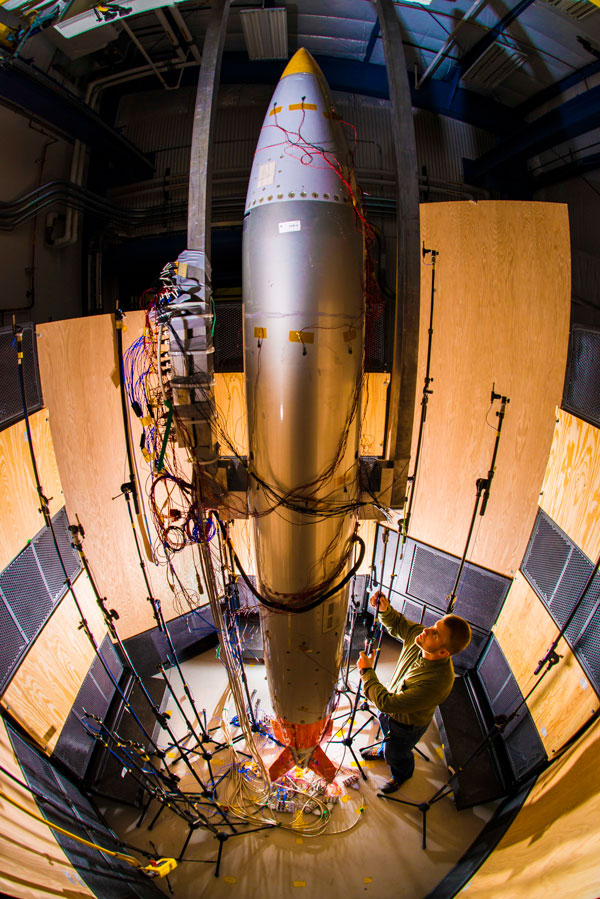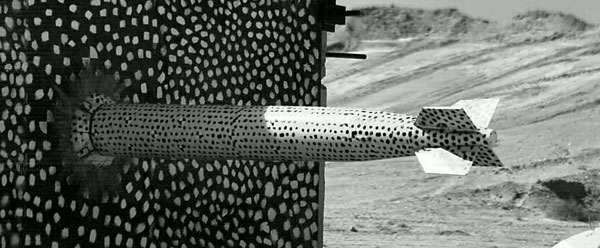
Sandia’s B61-12 nuclear weapons team has accomplished several milestones, including the gravity bomb’s final design review and the first production completion of several components for the life extension program.
“These are tremendous steps forward for the B61-12 Life Extension Program,” said Jim Handrock, weapon systems engineering director. “Through the hard work of many individuals, this program has successfully met all major deliverables on the path to providing a modernized nuclear deterrent for the nation. I am very proud of the work that Sandia has done over the years to get to this point.”
The B61-12 design was presented for final review by Sandia and Los Alamos national laboratories to an independent peer-review panel of 12 military and civilian experts last fall. The panel met at Sandia and examined electrical, mechanical, thermal and flight-testing data and analysis.
“The review represents a significant milestone for the program and the nuclear weapons complex as a whole,” said Jennifer Franklin, a manager on the final design review team. “It is the culmination of all the program design accomplishments to date and gives us confidence that the B61-12 system is ready to proceed forward with final design and production qualification activities.”
NNSA lists the final design review as one of the remaining major milestones for the B61-12 Life Extension Program before the first production unit, scheduled for 2020, and complete production in fiscal year 2025.
“The final design review assesses the weapon as a whole and the ability of the system to meet customer requirements,” Jennifer said. “A summary of all component-level final designs is provided to ensure previous action items are resolved. The review verifies there are no significant design details in flux, and the design can be reliably produced as defined.”
Refurbishment programs at Sandia
Sandia is the design and engineering lab for nonnuclear components of the nation’s nuclear stockpile, including the B61-12. In addition to nonnuclear component development, Sandia serves as the technical integrator for the complete weapon, assuring that the system meets requirements as a whole and not just as individual parts.
The B61-12 Life Extension Program will refurbish, reuse or replace all components to extend the bomb’s service life by at least 20 years and improve its safety, security and effectiveness.
Video: Watch a Tonopah Test Range B61 flight test in slow motion.
The first B61 entered service 50 years ago, and over the decades numerous modifications have been made to increase safety and reliability. The B61-12 consolidates and replaces most of the previous variants.
A life extension program allows scientists and engineers to address the aging of nuclear weapons components. Some components are reused by being requalified to go back into a weapon without change. Others that have aged are remanufactured using the original specifications. Sometimes the original technology is no longer available, and Sandia redesigns those parts using modern technology.
While the complete weapon system goes through a rigorous testing and review cycle before its first unit is produced, each component within the system also goes through a similar process of testing and qualification.
The B61-12 Life Extension Program teams have already produced first units for several components. The milestone marks the end of the design and development process Sandia teams have worked on for seven to eight years for those components.
“That’s why it’s such a big deal,” said Steve Moya, a manager with B61-12 product realization. “These teams have been working on this for the better part of a decade.”

Between now and when the weapon system will have its first units produced, Sandia will ready dozens of B61-12 components for production.
“We’ll hit a crescendo of activity this spring all the way through September,” Steve said.
“All design and development processes are approved, and the components are qualified for high reliability,” said Jerry Stoughton, a former product realization manager with the B61-12 program. “They can be produced with the approved processes.”
Reaching the first production milestone for a component means it has undergone an extensive set of tests to ensure it always works when authorized and never otherwise.
Impact, vibration, drops, extreme temperatures and massive electrical impulses are just some of the tests conducted to show a component will operate as intended, as part of the overall system.
“They’ve all been put through the shake, rattle and roll testing,” said Jerry, who is now a flight systems project manager. “There are really two conditions for testing, a normal environment and an abnormal environment. Those are both covered with extensive computational analysis and testing.”
The pairing of computational analysis and advanced computer algorithms with field testing data, including flight tests at Sandia’s Tonopah Test Range, have added a high degree of confidence in the B61-12 design, Jennifer said. “All the evidence comes together — demonstration, analysis and tests — to show that the design meets requirements,” she said.